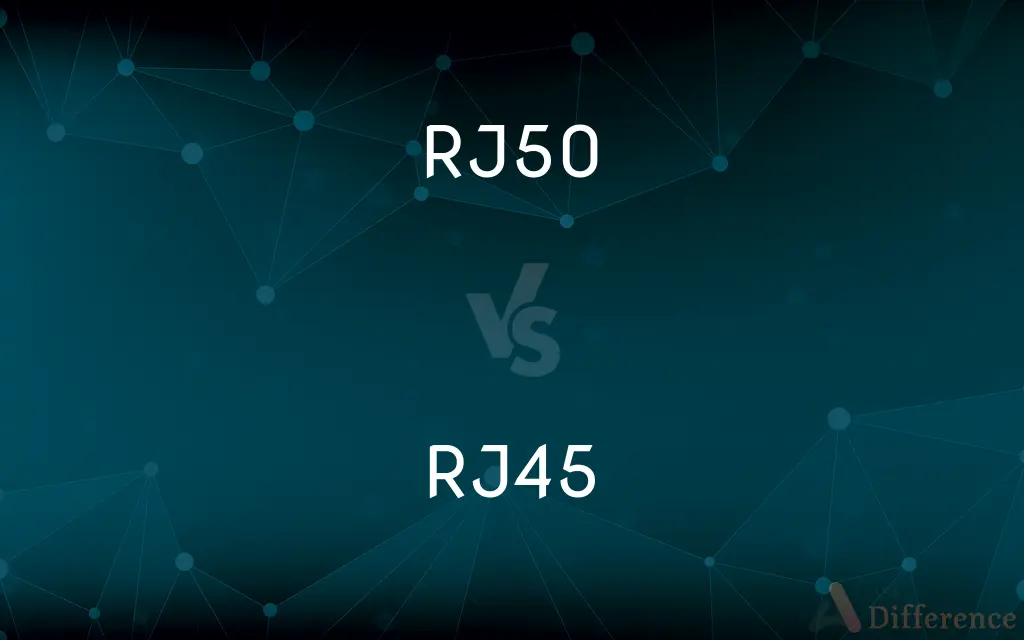RJ50 vs. RJ45 — What's the Difference?
By Tayyaba Rehman — Published on January 27, 2024
RJ50 is a 10-pin connector used for specialized applications, while RJ45 is an 8-pin connector standard for Ethernet and network cables.

Difference Between RJ50 and RJ45
Table of Contents
ADVERTISEMENT
Key Differences
RJ50 connectors are less common and feature a 10-pin configuration. They are typically used in specialized telecommunication, industrial, and networking equipment where more pins are required for additional functionality. RJ45 connectors, in contrast, are standard 8-pin connectors widely used in Ethernet and network cables for both commercial and residential networking.
The physical size of RJ50 connectors is slightly larger due to the additional pins, making them incompatible with RJ45 ports. RJ45 connectors are smaller, designed to fit universally in network ports found in computers, routers, and switches. The size difference ensures that each type of connector is used in its appropriate context without confusion.
RJ50 connectors are often found in specific applications such as advanced telecommunication systems, certain types of data equipment, and industrial control systems. On the other hand, RJ45 connectors are a cornerstone in setting up local area networks (LANs) and are essential for connecting various Ethernet-compatible devices.
In terms of wiring standards, RJ50 connectors may follow different wiring schemes based on their specific application, which requires careful attention during installation or troubleshooting. RJ45 connectors typically adhere to standardized wiring schemes like T568A and T568B, which are universally recognized and used in network cabling.
RJ50's specialized nature means they are less common in general consumer electronics and more likely to be seen in industrial or specific telecommunication environments. RJ45 connectors are ubiquitous in the field of networking and are considered the standard for Ethernet and internet connectivity.
ADVERTISEMENT
Comparison Chart
Pin Configuration
10 pins.
8 pins.
Physical Size
Slightly larger due to more pins.
Standard size for Ethernet and network ports.
Common Usage
Specialized telecom, industrial systems.
Ethernet and network cables in LANs.
Wiring Standards
Varies by application.
Typically T568A and T568B standards.
Prevalence
Less common, more specialized.
Ubiquitous in networking and internet connectivity.
Compare with Definitions
RJ50
Requires specific wiring schemes.
Wiring the RJ50 connector required referencing the system's specific diagram.
RJ45
An 8-pin connector standard in Ethernet networking.
He connected the router to the modem using an RJ45 cable.
RJ50
Less commonly used in consumer electronics.
The technician explained that RJ50 connectors are rare in home networks.
RJ45
Follows T568A and T568B wiring standards.
While crimping the RJ45, he ensured to follow the T568B standard.
RJ50
Slightly larger than standard network connectors.
He noted the RJ50's size difference when installing the telecom system.
RJ45
Universally used for LAN and internet connections.
RJ45 ports were available on all their office computers for network access.
RJ50
A 10-pin connector used for specialized equipment.
The industrial control panel required an RJ50 connector for additional functionality.
RJ45
Essential for setting up local area networks.
Installing the LAN required numerous RJ45 connectors and cables.
RJ50
Found in advanced telecommunications and data equipment.
Their advanced networking setup utilized RJ50 connectors for complex tasks.
RJ45
Compatible with various Ethernet-compatible devices.
They used RJ45 cables to connect the network printers.
Common Curiosities
Are RJ45 connectors easy to install?
Yes, with basic tools and following standard wiring schemes.
Are RJ45 cables used for DSL internet?
Yes, RJ45 is standard for Ethernet connections in DSL setups.
Is RJ45 used for wireless connections?
No, RJ45 is for wired Ethernet connections.
What devices use RJ50 connectors?
Specialized telecom systems and industrial equipment.
Can I replace an RJ50 with an RJ45?
Not directly, as they serve different purposes and sizes.
Do RJ50 connectors fit in standard network ports?
No, they are larger and meant for different applications.
Is RJ45 compatible with regular internet routers?
Yes, it's standard for connecting to most routers.
Can RJ50 be used in a home network?
It's uncommon, as home networks typically use RJ45.
Does RJ50 require specialized knowledge to install?
Often yes, due to its varied applications and wiring schemes.
Are RJ50 and RJ45 interchangeable?
No, they have different pin configurations and uses.
Can RJ45 support gigabit internet speeds?
Yes, with the appropriate cable category like Cat5e or Cat6.
Is soldering required for RJ45 connections?
No, RJ45 connectors are typically crimped, not soldered.
Do I need a special tool to crimp RJ45 connectors?
A standard crimping tool for RJ45 connectors is required.
Are RJ50 cables commonly found in electronic stores?
They are less common and may not be readily available in standard electronics stores.
Can RJ50 be used for regular telephones?
No, it's for more specialized telecommunications equipment.
Share Your Discovery

Previous Comparison
RedWeek vs. Vrbo
Next Comparison
38 Special vs. 380 AutoAuthor Spotlight
Written by
Tayyaba RehmanTayyaba Rehman is a distinguished writer, currently serving as a primary contributor to askdifference.com. As a researcher in semantics and etymology, Tayyaba's passion for the complexity of languages and their distinctions has found a perfect home on the platform. Tayyaba delves into the intricacies of language, distinguishing between commonly confused words and phrases, thereby providing clarity for readers worldwide.













































